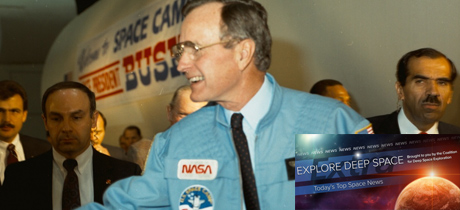In Today’s Deep Space Extra… Former President George H.W. Bush is remembered for his passion for human space exploration. China prepares to launch the first spacecraft lander mission to the Moon’s far side. Russian space veteran questions his nation’s space commitment.
Human Space Exploration
Bush remembered for role shaping post-Cold War space policy
SpaceNews.com (12/5): Wednesday has been designated a National Day of Mourning for the late President George H.W. Bush, who passed away last Friday at home. He was 94. While President, Bush took measures to return human explorers to the Moon and enable post-Cold War relations with Russia that eventually led to the assembly of the International Space Station (ISS). “President George H.W. Bush was not only a passionate space enthusiast, he was a visionary who outlined the keys to the next great step in American space exploration,” said Mark Albrecht, who was executive secretary of the National Space Council during the Bush administration.
Building gas stations and McMurdo scale outposts on the Moon
Universe Today (12/4): Antarctica and the McMurdo Station may offer one Earthly analog for what human explorers might encounter as the U.S. returns to the Moon with private sector and global partners. One incentive for making the difficult journey could be frozen water and other potential lunar resources. Water, for instance, could be refined into rocket fuel and provide human life support assets.
Space Science
So what’s the big deal about Mars InSight?
The Hill (12/3): Former NASA Administrator Sean O’Keefe offers an answer to the “Big Deal” question in an op-ed that touts the capabilities of InSight, which soft landed on Mars last week to lay some groundwork for the eventual human exploration of the red planet. NASA is making progress in deep space travel and in protecting the health of future human explorers who could journey for months to years in order to explore Mars, O’Keefe notes.
What’s next for NASA’s OSIRIS-REx probe at asteroid Bennu?
Space.com (12/4): The Osiris-Rex spacecraft, NASA’s first effort to obtain and return samples from the surface of an asteroid, reached its distant destination, the asteroid Bennu, at mid-day on Monday. Next comes a lengthy reconnaissance by sweeping over Bennu’s surface at low altitude to set up a brief landing in mid-2020 to collect soil and rock. Osiris-Rex’s asteroid bounty is to return to Earth in September 2023.
China to launch Chang’e-4 lunar far side landing mission on December 7
GB Times of Finland (12/5): China has set Friday for the launch of the first spacecraft intended to land on the Moon’s far side. The destination is the South Pole Aiken Basin, a large impact crater that could hold new scientific information about the Moon’s past and ice, a resource. The Chang’e-4 lander and rover may touchdown in early January 2019, though an official date has not been announced.
A comet as big as the full Moon
Spaceweather.com (12/4): More on a comet on course to be one of the closest to ever approach Earth. December 16 is the forecast close approach date for Comet 46P/Wirtanen. Despite its full Moon size, it’s unclear whether Wirtanen will reach naked eye brightness. In the meantime, recent stellar activity could mean bright aurora Wednesday night.
Other News
The old guard may be turning against the Russian space program
Ars Technica (12/4): Long time cosmonaut and space industry executive Valery Ryumin offers a worrisome view of his country’s space program future, based on his assessment of current leadership and absence for adequate funding to develop deep space hardware.
Pentagon analyzing possible missions for a new Space Development Agency
SpaceNews.com (12/4): A new U.S. space agency, a Department of Defense (DOD) Space Development Agency, could be a catalyst for innovation in military space, according to Deputy Defense Secretary Patrick Shanahan and Mike Griffin, the Defense undersecretary for research and engineering. Shanahan proposed the move in August. Leveraging commercial space technologies would be a major focus for the development of new space national security capabilities.
Arianespace launches two Asian satellites on Ariane 5 rocket
SpaceNews.com (12/4): An Ariane V rocket, launched Thursday from French Guiana, placed two Indian and Korean telecommunications and weather satellites into geotransfer orbit.

